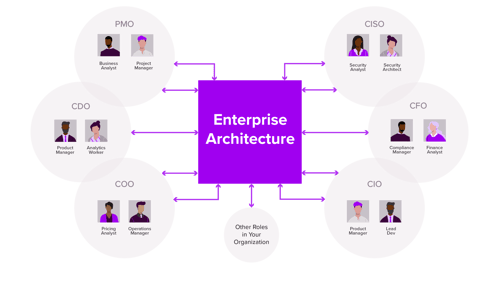EA is reinventing itself for the digital age. Discover its new 'secret sauce'.
EA has always been a complex endeavor. Its standards, frameworks, and architecture require a high degree of expertise and technical knowledge to understand, making it the exclusive preserve of IT leaders and enterprise architects.
This arrangement works well enough in a business-led, IT-enabled environment, where the goal is to align business and IT. Now the complexities introduced by digital transformation have disrupted this model. Digital businesses no longer operate as discrete entities. Instead they face outwards as participants in a digital business ecosystem of customers, partners, organizations, and things, where waves of technological innovation is driving continuous evolution.
Not only does this make EA's task far more complex, it also results in a digital business strategy that sees business, IT, and technology as inextricable from one another. This means that non-tech business leaders, including the C-suite, are more involved in IT and tech decision-making.
Now the key challenge for EA is to make itself accessible to a wider audience who would otherwise find its outputs impossible to decipher. EA needs to have a rethink about what is its most important part. Is it the architecture, or something else?
![AR---AT---A-shift-in-focus-for-EA-[Inline]](https://www.ardoq.com/hs-fs/hubfs/TP%20CPD%202018/Blogs/AR---AT---A-shift-in-focus-for-EA-%5BInline%5D.jpg?width=780&name=AR---AT---A-shift-in-focus-for-EA-%5BInline%5D.jpg)
A shift in focus for EA
To answer that question, we need to ask another question: what do digital business leaders really need from EA? They want intelligence and insight about their operations so that they can manage complexity, rapidly adapt to change, survive extreme competition, and leverage new business opportunities.
Most business leaders, as well as many EA practitioners, would agree that the traditional practices of EA fall well short of delivering this outcome. The main problem is that it isn’t possible to use rigid architecture and frameworks to provide that intelligence in a business ecosystem that evolves in real-time. The latest model will always be obsolete – missing some new process, system or integration. Diagrams become so complex that they cannot be visually analyzed for errors and inconsistencies.
Resolving that issue means examining the underlying data to find any gaps. But the volume of data generated by a digital ecosystem is vast, beyond the means of any individual to process. There is a solution, though. Data analytics. The right application of this technology will crunch the data to provide valuable insights that would not have otherwise been apparent.
So in the digital era, the key challenge for EA is not architecture but data and analytics.
![AR---AT---Data-is-fundamental-to-the-new-EA-[Inline]](https://www.ardoq.com/hs-fs/hubfs/TP%20CPD%202018/Blogs/AR---AT---Data-is-fundamental-to-the-new-EA-%5BInline%5D.jpg?width=780&name=AR---AT---Data-is-fundamental-to-the-new-EA-%5BInline%5D.jpg)
Data is fundamental to the new EA
If data analytics is the true driver of EA, then its best practices also apply to EA. The most important part of any data analytics program is its data. Therefore this is also true of EA.
New EA is a data and analytics challenge. It's moved on from being about architecture to being about data input processing and data output. That's not to say that architecture is unimportant. It clearly is – because without it there wouldn't be any project at all. However, it all starts with the right data. If the data being fed into the analysis is of poor quality, the project is compromised from the very start.
The success of any analytics project is determined at its 'edges' – that is by its inputs and outputs. Very few analytics projects fail because its core analysis and algorithms are deficient. The most common cause of failure is the inability to input data and poor quality data.
Therefore the success of any new EA project will be determined by the quality of its data.
![AR---AT---Inputting-the-right-data-is-critical-[Inline]](https://www.ardoq.com/hs-fs/hubfs/TP%20CPD%202018/Blogs/AR---AT---Inputting-the-right-data-is-critical-%5BInline%5D.jpg?width=780&name=AR---AT---Inputting-the-right-data-is-critical-%5BInline%5D.jpg)
Inputting the right data is critical
New EA is only as good as its data – so its primary focus should be on making it easy to submit data into its platform in the right format. The process should be highly automated and easy to operate manually – for example APIs can access record data or pre-built data import integration can draw in data from other programs such as Excel and AWS.
There should also be the facility to harvest complementary data from across the organization so that a more diverse range of stakeholders can participate in the EA program. No-UI, no-new-solution-training data collection can provide this benefit.
Lastly, for the data to generate intelligence that business leaders will find useful, it must be of the right type. For example, if the business needs to understand how enhanced process efficiency is contributing to lower its costs, only certain types of data will allow EA to provide the answer. The data entering the platform must carry the right signals to generate the desired deliverables.
![AR---AT---Outputs-determine-success-[Inline]](https://www.ardoq.com/hs-fs/hubfs/TP%20CPD%202018/Blogs/AR---AT---Outputs-determine-success-%5BInline%5D.jpg?width=780&name=AR---AT---Outputs-determine-success-%5BInline%5D.jpg)
Outputs determine success
Presenting business leaders with the printed outputs of an analytics program will have very little impact. What they need is intelligence that will help them make a better decision. An output that only a couple of experts in the organization can understand will be entirely useless to them.
Any analytics tool or operational project is only as good at the guidance it can provide. The actual numbers outputted are meaningless to senior decision-makers – it's really how this is applied that is significant. The skill in new EA lies in how to make its analytics output accessible to a varied audience of stakeholders. If it can be presented from their point of view, speak their language and be customized to deliver the insights they seek, then the EA program can be judged as a success.
Conclusion
By focusing on the data rather than on the architecture, new EA can prove its value to the fast-evolving businesses of the digital era. It ensures that its projects 'succeed at the edges', by inputting the right data and outputting deliverables that offer tangible benefits to the business. In this way, it leaves behind its reputation for insularity and instead becomes a powerful source of intelligence for all senior decision-makers, including those without expert technical knowledge.
 Ardoq
This article is written by Ardoq as it has multiple contributors, including subject matter experts.
Ardoq
This article is written by Ardoq as it has multiple contributors, including subject matter experts.







